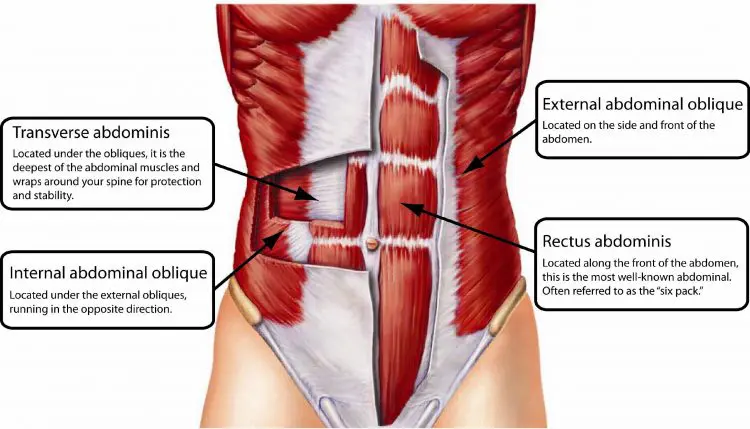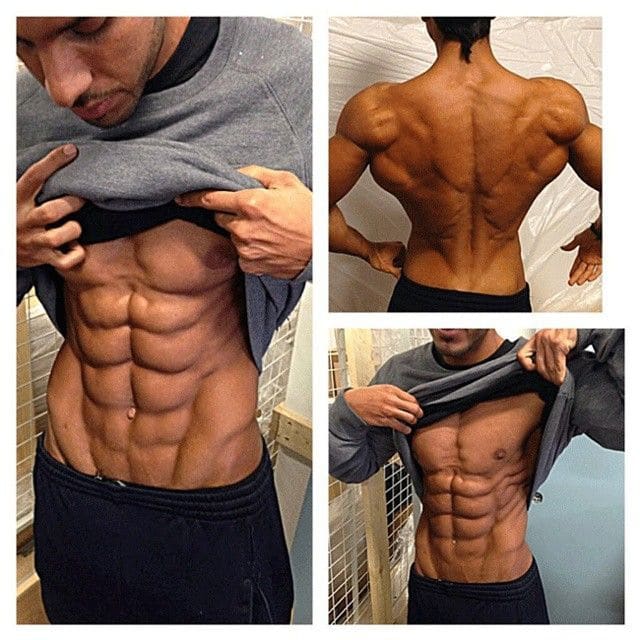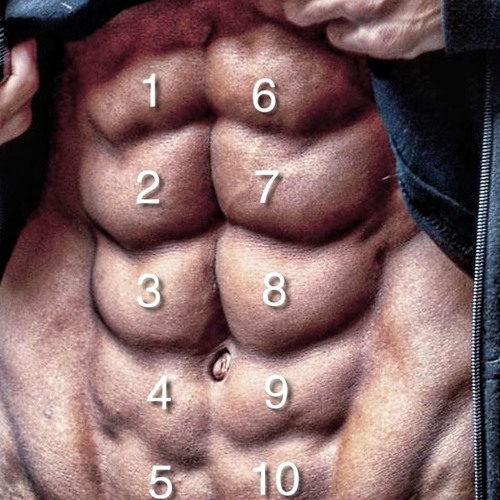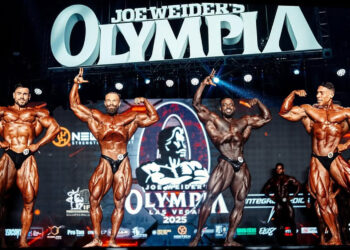Abs are probably one of the most sought-after muscle groups. Ask a gym newbie about his training objectives, and a ‘shredded abdomen‘ will probably be amongst his top two goals.
A perfectly chiseled midsection is often associated with peak fitness levels. And given the strict diet and training required to build abs, we wouldn’t argue with the assumption.
But if you google “abs” and head to the “images” section, you will notice that not all toned abs look the same. While some people have a four-pack, others outdo them with a shredded six-pack.
The images could break the hearts of thousands of fitness enthusiasts who spend hours crunching every day in hopes of building a solid six-pack.
Ask a bro in your gym why Arnold Schwarzenegger had a four-pack while Kai Greene has a six-pack, and he will probably tell you that Arnie did not focus on his abs enough since it was not the trend back in the day.
As you might have guessed, the brofessor has got it all wrong. Your ab structure depends on a wide range of factors other than your training, and we will dig deep into the topic in this article.
Level Up Your Fitness: Join our 💪 strong community in Fitness Volt Newsletter. Get daily inspiration, expert-backed workouts, nutrition tips, the latest in strength sports, and the support you need to reach your goals. Subscribe for free!
Also, if you have ever wondered WTF is wrong with Dwayne “The Rock” Johnson’s abs, you should check out this piece.
The Abs Anatomy

Our goal with this article is to help you shorten your learning curve and build ripped abs at the earliest.
So, if you want eight-packs abs like Ulisses Jr, believe us when we tell you that you cannot. Well, technically, you can if you are willing to go under the knife, but it is highly unlikely naturally.
Do not get us wrong. We are not doubting your dedication or commitment by any stretch of the imagination. However, we want to bring to your attention that your ab-building goal could be biologically impossible.
Confused? Let us explain.
Before we get into why your abs will most probably never look like that of your favorite superhero, we should first understand the muscle composition of your abdomen.
The Four Abdomen Muscles
Your abdomen consists of four muscles; the rectus abdominis, linea alba, transverse abdominis, and the internal and external obliques. Each of these muscles has a role to play in your ab structure.
Now, I could show you a photo of my shredded 10-pack to teach you everything about the abdomen anatomy, but my editor tells me I need to be a little more humble, so we will make do with some anatomy illustrations.
1. Rectus Abdominis
The rectus abdominis (Latin for straight abdominal) is the muscle people are usually referring to when they talk about abs. Contrary to what most people think, the rectus abdominis does not run horizontal to your abdomen.
The Rectus abdominis is made up of two connected muscle bands that run parallel down either side of your abdomen.
Another common misconception people have is that the rectus abdominis consists of 2-12 muscles.
However, rectus abdominis are paired straight muscles that are traversed by a band of connective tissues, separating them into distinct muscle bellies. These connective tissues are what give you the 2, 4, 6, 8, 10, or 12 packs.
Functions of Rectus Abdominis
- Plays a vital role in maintaining your posture.
- Responsible for flexing the lumbar spine (imagine doing a crunch).
- Assists with breathing and plays an important role in respiration.
- Helps in keeping internal organs intact and in creating intra-abdominal pressure.
2. Linea Alba
First, we know what you are thinking. Yes, it reminds us of Jessica Alba too. Second, no, it is not funny.
The linea alba is a midline band of connective tissue that separates the rectus abdominis twins. It is the line that runs between your abs and adds to the aesthetics.
Functions of Linea Albs
- Stabilizes the anterior abdominal wall by balancing the contractile forces from the muscles attached to it.
- A median incision through the linea alba is a common surgical approach for abdominal surgery. Fitness model Alexia Clark’s abdominal surgery is the most recent example.
3. Transverse Abdominis
The transverse abdominal muscle (TVA) is located deep inside your torso.
The TVA is also known as the transversalis muscle and transversus abdominis muscle. It is the muscle Classic Physique athletes (or any individual, for that matter) rely on to hit the vacuum pose.
The muscle extends from the front of the abdomen around the sides of your body. It is positioned immediately inside the internal oblique muscle.
Functions of Transverse Abdominis
- It helps compress the ribs and viscera, providing thoracic and pelvic stability.
- Helps pregnant women deliver children.
4. Internal and External Obliques
External obliques are a large muscle group located at the sides of the rectus abdominis, while internal obliques are located inside your hip joints. Working your obliques adds definition and tone to your abs.
Functions of Internal and External Obliques
- Internal and external obliques help control the twisting and turning movements of your body.
- They provide a stabilizing girdle for your back and pelvis.
Myths About Building a Six-Pack or Eight-Pack
Ab training is surrounded by myths that refuse to die. Some of the most common myths include:
1. Workouts and Diet Are the Be-All and End-All of Building Abs
Like it or not, genetics plays the most important role in determining how your abs are going to turn up. Although every individual has two rectus abdominis muscles, we do not have the same number of bands of connective tissue running horizontally across our abdomen.
These horizontal bands, stacked on top of each other, are responsible for giving the appearance of a six-pack or eight-pack. No matter how many hanging leg raises you do, you cannot upgrade from a four-pack to a six-pack.
Check Out: Top 5 Bodybuilders With The Best Genetics Ever
2. You Need to Train Your Upper, Middle, and Lower Abs
But so many people divide their ab training into upper, middle, and lower workouts. Are they all making it up?
Guess what, even dinosaur sounds are made up. No human knows what a T-Rex or Ankylosarurs sounded like. A group of people just made it up, and we have all been living with it ever since. So to answer your question, yes, the upper, middle, and lower ab training circuits have no evidence backing their effectiveness.
Level Up Your Fitness: Join our 💪 strong community in Fitness Volt Newsletter. Get daily inspiration, expert-backed workouts, nutrition tips, the latest in strength sports, and the support you need to reach your goals. Subscribe for free!
You cannot isolate and target your middle or lower abs while performing crunches or leg raises. Your genetics determine the symmetry, length, and size of your abs.
Remember: The rectus abdominis is just one muscle that either contracts together as one or does not contract at all.
3. The Buck Stops at 8-Pack Abs
Some fitness enthusiasts make the mistake of fixating on building an eight-pack. While a ripped abdomen can be aesthetically appealing, it does not guarantee a strong core.
It does not matter how many connective bands you are born with, you need to focus on the overall development of your physique. Also, if you are born with three segmentations of connective tissue, even Rhonda Byrne’s “The Secret” cannot help you build the fourth band.
4. To Build an 8-pack, You Need to Focus on Spot Reduction
Do a google search on how to build a shredded six-pack and watch the creepy web trackers bombard you with a barrage of products that guarantee spot fat reduction. Herbal green tea, sauna belts, vibrators (not the ones you are thinking about, pervert), you know the works.
If you want to build a chiseled midriff, you need to have a low body fat percentage and perform exercises that strengthen your core. There are no shortcuts to an eight-pack.
4-Pack vs 6-Pack vs 8-Pack Abs Ratios
With all said and done, you should not plainly accept that you are never going to have more than a six-pack. You could have won the genetic lottery, for all we know.
So, if you are wondering about your odds of having a 10-pack, we have some numbers for you.
A study was conducted on cadavers to identify the variations of the location and patterns of the tendinous intersections of the rectus abdominins muscle. Here are the findings:
- 10-Pack: ~1% (*no concrete studies on this but seemingly more rare than a 2 Pack)
- 8-Pack: ~22%
- 6-Pack: ~61%
- 4-Pack: ~15%
- 2-Pack: ~2%
Note: No cadavers in the study had a 12-pack, but it has been reported that 12-packs were present in some autopsies.
Check Out: Body Fat Calculator: Find Your Body Fat Percentage
How To Test For Abs
If you are lazy and want to test how many abs you might have without actually losing weight and body fat, you could follow the 10-pack ab test.
Here is the 10-pack ab test:
- Stand upright and grab as much of the fat and skin that you can around the area of your belly button with your fingers pointed inwards.
- Pull the fat and skin outwards.
- Contract your muscles underneath your skin and fat, and you will notice that they pull away from this tissue and make it easier for you to distinguish the pure muscle below.
- Now, use your pointed fingers to “strum” up and down on the rectus abdominis muscle below your belly button.
- If you can feel a line at the level of the belly button, then you can develop a solid six-pack as the connective tissue band that runs from the linea alba is present and dividing your abs.
- From here, move your fingers lower and see if you can find another horizontal band of connective tissue.
- Continue moving south and uncovering more connective bands.
How To Build Better Abs
Now that you know everything about building a shredded midriff, it is time we get down to business. Follow these tips to build better abs:
1. Bring Down Your Body Fat Percentage
If you want solid abs, you need to lower your body fat percentage. There are no two ways about it. Here is the relationship between body fat and ab visibility:
- 20%+: With such a high body fat percentage, you will be soft around your midsection, and your abs will not be visible.
- 15-19%: It can be considered healthy, but it is unlikely that you will see any ab definition.
- 10-14%: This range of body fat is considered lean, which means your abs will be visible.
- 5-9%: You will be peeled AF.
Here are a few ways of bringing down your body fat:
- Follow a calorie deficit diet.
- Eat a protein-rich diet.
- Include LIIT and HIIT cardio into your training regimen.
2. Build the Abdominal Muscles
Abs are just like any other muscle group in your body. You should use the progressive overload principle to ensure the overall development of your abdominal muscles by increasing the total volume of your workout either through more sets and reps or adding resistance.
Other than doing ab exercises, you should also include compound moves like the squat and deadlift into your training as they can help in building a stronger core. As you hypertrophy your abdominal muscles, they will stand out more and help make the cuts more visibly deep in the process.
Must Read: Muscle Development With Progressive Overload – The Concept You Must Know To Grow!
3. Make Isometric Exercises Your Darlings
Isometric exercises like the plank are among the most effective abdominal exercises. These are excellent for achieving better tone and definition in the rectus abdominis muscles.
4. Work on Your Obliques
If you are not satisfied with your ab development, your next step should be to build shredded obliques. Why is that, you ask?
As President Truman once said, “If you cannot convince them, confuse them.”
The external obliques begin at the sides of your abs and then run upwards around your torso. Building the obliques will add to the aesthetics of your midsection.
Why Are Abs More Prominent in Men?
If you look for your fitspo on Instagram every day (like yours truly), you might have noticed that male fitness athletes have more pronounced abs than women.
Women require more body fat than men. The reasons for this include:
- Estrogen production requires body fat.
- Women need a higher body fat percentage to maintain optimal energy levels throughout the day.
- Healthy fertility.
These are the main reasons it is harder for women to lose enough abdominal fat to reveal shredded abs. Women who push their bodies too hard to shed the essential body fat often struggle with fatigue, menstruation issues, and a weakened immune system.
On the other hand, men require less body fat for optimum health and functioning. In effect, men can lose a higher degree of body fat to reveal shredded abs and maintain the conditioning for longer without significant side effects.
The Most Effective Ab Workout
How could we end this article without an ab workout? The workout laid out below will help you bring out your abdominal muscles and improve your conditioning.
- Cable Crunch: 3 sets of 8 reps
- Captain’s Chair Weighted Knee Raise: 3 sets of 10 reps
- Barbell Rollout: 3 sets of 6 reps
- Bicycle Crunch: 3 sets of 10 reps
- Plank: 3 sets to failure
Wrapping Up
Abs can be one of the most stubborn muscle groups to develop. Not only do they require a ton of dedication and persistence to build, but they also demand a lifestyle shift if you want to sport them throughout the year.
If there was only one thing that you could take away from this article, let it be this – your genetics might decide the number of abs you can have, but that should not stop you from working hard on making them look like the best abs in the world.











